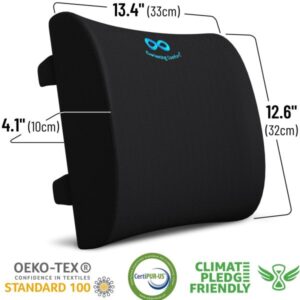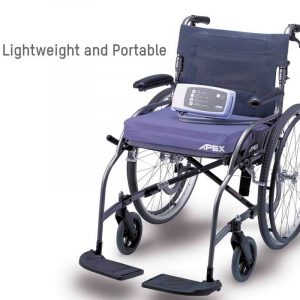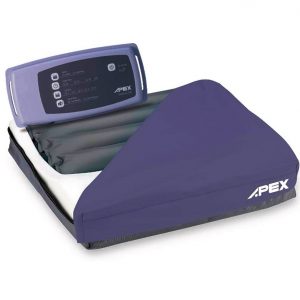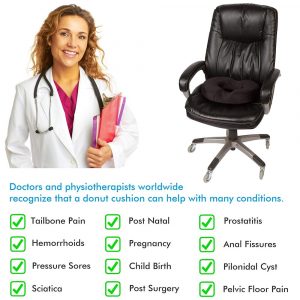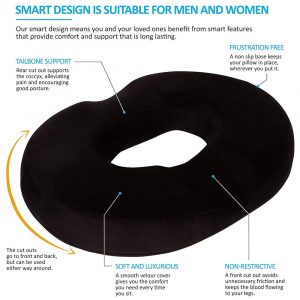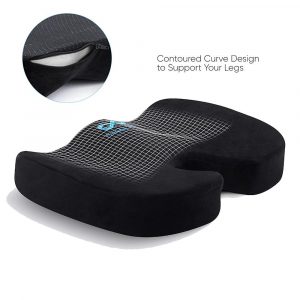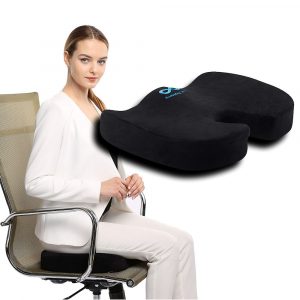Back Pillows Promote Good Posture, Relief From Pain And Improve Comfort While Sitting
The area that most back pillows are concerned with is the lumbar spine where the majority of low back pain occurs – within the lower lumbar region. Of this, most pain related problems fall within the fourth and fifth lumbar vertebrae which sit atop the sacrum, a larger triangular bone. As the last movable joint along the spine, the lumbosacral joint, where the fifth lumbar connects to the sacrum, bears greater weight and stress and has a greater risk of strain or injury.
Although bad sitting posture can effect the neck, many back problems are the result of wear, tear and abuse occurring over an extended period of time, rather than a single traumatic injury or event.
Similar to the neck, some 80 percent of repetitive stress disorders, particularly in the lumbosacral area, are caused by poor posture, fatigue and exhaustion. Back support pillows can help prevent postural stress, relieving pressure and pain by supporting the lumbar spine, the pelvis or both.
With the center of gravity of the spine at the lumbosacral area, and sitting producing a large amount of disc pressure, back support pillows can help prevent misalignments from bad back posture posture which often result in dysfunction in the body and pain. The lack of adequate support by chairs, seats and sofas encourages an unbalanced posture and the flattening of the lower back curve levers the head forward causing poor neck posture.
Poor posture, fatigue and exhaustion are common causes of low back pain and are frequent complaints from those who sit for long periods of time at work and when traveling. When traveling, hauling heavy objects like luggage and children through airports and hotels and sleeping in strange beds with unfamiliar pillows can leave your back aching for relief. Although just part of the equation, back support pillows can help.
Whether traveling or at a desk, prolonged sitting will fatigue the back muscles and eventually, one slips into a poor or slumped posture. Sitting involves disc pressures that are significantly greater than standing. Slumping forward or backward magnifies the pressure on the back. Using back support pillows can reduce disc pressure and relieve strain on the back muscles.
The use of office chairs for extended periods is associated with back pain and is a crucial factor for decline in work productivity. Relief and increased work productivity can be enhanced with increased comfort through better ergonomics. In order to increase comfort and decrease the risk of injury, ergonomic seating typically employs support for the lumbar spine to keep the lower back in a more natural posture, reducing muscular strain and stress on joints and discs
Can Back Pillows Help?
- With the use of back pillows to help maintain an upright position while sitting, the disc pressure can be reduced as much as 100 lbs. over a slumped forward posture. Additionally, according to the journal, Ergonomics, Volume 52, Issue 7 July 2009 , car driving is associated with the risk of developing low back pain and this may be related to exposure to whole body vibration. The study found that use of a movable back support reduces the transmission of vibration through the trunk and that it reduces low back muscle strain.
- A study in the 2014 European Spine Journal used MRI to evaluate 90 patients to determine factors influencing lumbar spine disc and endplate degeneration. Of all the factors considered, having a greater lumbar curve was found to be a protective factor for degeneration of the lower back. This indicates that supports that help maintain the normal curve are useful in helping protect the back from pain.
- A 2015 study in the Asian Spine Journal. Indicated prolonged sitting is an important risk factor for back pain. They noted that the alignment of the spine and pelvis is important to maintain a posture that is energy efficient. In the study, the authors found that sitting significantly decreases the lower back alignment and alters the pelvic angle. They further indicate that this sitting imbalance can result in chronic lower back pain. The study revealed that using a back pillow support while sitting resulted in less changes to the spinal and pelvic alignment, resulting in a more ideal position.
- A 2022 study in Pain Reports indicates confirms that a lumbar support helps to prevent the development of low back pain as prolonged sitting with a reduced lumbar curve may increase strain and increase the risk of hyperflexion injury to the disk and ligament, which can be minimized by using a lumbar support that contributes to maintaining the natural lordotic curvature of the lower back.
- A 2021 study in World Neurosurgery found compared to standing postures, slumped sitting was loss of lumbar spine lordosis (curve) and loss of disc height. The authors concluded the postural imbalances noted resulted from long standing lower lumbar spine bending forces which over stretch ligaments during slump sitting.
- A 2013 study in Chiropractic & Manual Therapies Journal indicted using a back support pillow was able to increase comfort in those with back pain as well as healthy individuals and improving seated posture.
An easy approach is use a forward tilting seat wedge which increases the sacral base angle, helps reduce backward slippage of the lower spinal segments and reinforces the correct lumbar lordosis. Use for short periods until enough strength is built up to using most of the day. This changes the harmful effects of prolonged slumped sitting into a force for correcting this imbalance.

What Is The Best Sitting Posture
While sitting, the back-rest of the chair should be tilted slightly backward at an angle of 95-105º. A seat that is too low places stress on the ischial tuberosities (sit bones), while a seat that is too high places pressure on the thighs. If your seat does not have an adjustable height, you may need to use a footrest. The edge of the seat should not touch the back of your knees. The angle of the seat should be slightly forward to help maintain the normal curvature of the low back. Since most seats do not adjust in this manner, a seat wedge can provide a nice solution. More information about the ergonomics of sitting
With many different body shapes and seating types, many different styles of back pillows are available. While foam comfort supports are common, others use fiber, rigid plastic or air bladders. Cushions that you sit on can provide posture improvement for the low back, while improving the seating surface and can also provide therapy for the back muscles while sitting.
Does Back Posture Affect The Neck?
- A 2018 study in the Journal of Physical Therapy Science found that using a back support that maintains the normal back curve has a direct relationship to improvement of neck posture. The authors found that prolonged sitting reduces the normal lumbar lordosis and this is associated with a forward head posture. A sitting position with the back support showed significantly greater improvements in neck posture, along with decreased muscle tone and stiffness of the upper trapezius muscle in those suffering from forward head posture.
What Is The Best Back Support Pillow?
There are a number of factors involved in choosing one. Will it be stationary? If you will be using it in different locations, a lightweight support is a good idea. The spinal supports are very good, but are heavier and a bit more difficult than the others. These are best secured to your chair or car seat and left there. Price is also a consideration; the two mentioned are more expensive, but are very well constructed, provide a high level of support, will last for many years, and are measured to fit your body size. A really good basic back cushion effects the lumbar curve and can help with muscle fatigue. It is very light and portable. The foam based supports have been used for many years and come in different sizes, as well as affordable and are a good place to start.
Why Don’t Back Pillows Help Me?
There are some conditions where having a greater lumbar lordotic curve will cause more pain. One must always consider the reason why they have pain. While this is often very complicated and can be multi-factorial, conditions that cause stenosis or narrowing of an opening; either for the spinal cord or a spinal nerve may get worse with extending the lower back. Often conditions like spinal stenosis, facet joint problems, or a pinched nerve are relieved better with flexion or reducing the curve of the lower back. Under these circumstances, a back support pillow may not be appropriate. Sometimes, a small amount of support is beneficial, so either the back support tension can be reduced, or a thin foam support might help. One of the mistakes is too much support, too fast. That is why having an adjustable support is most likely to be beneficial.
We find mainly that conditions will cause a reduction of the lower back curve. Muscle spasm and poor posture are often responsible. These conditions can greatly benefit from increased support. You have to find a mechanical component to the pain. If you arch back to increase the curve, does it feel good? Many who sit for long periods will often stretch like this. This is because the muscles and ligaments get overstretched, causing increased pressure on discs or inflammation from arthritis.
Some herniated discs respond to extension or backward stretching better than forward bending. To test, you can roll up a small towel and place this behind your back while sitting. Increased comfort means you will likely have a good response with a back support, while increased pain may indicate back pillows may not be the best way to approach pain relief.







